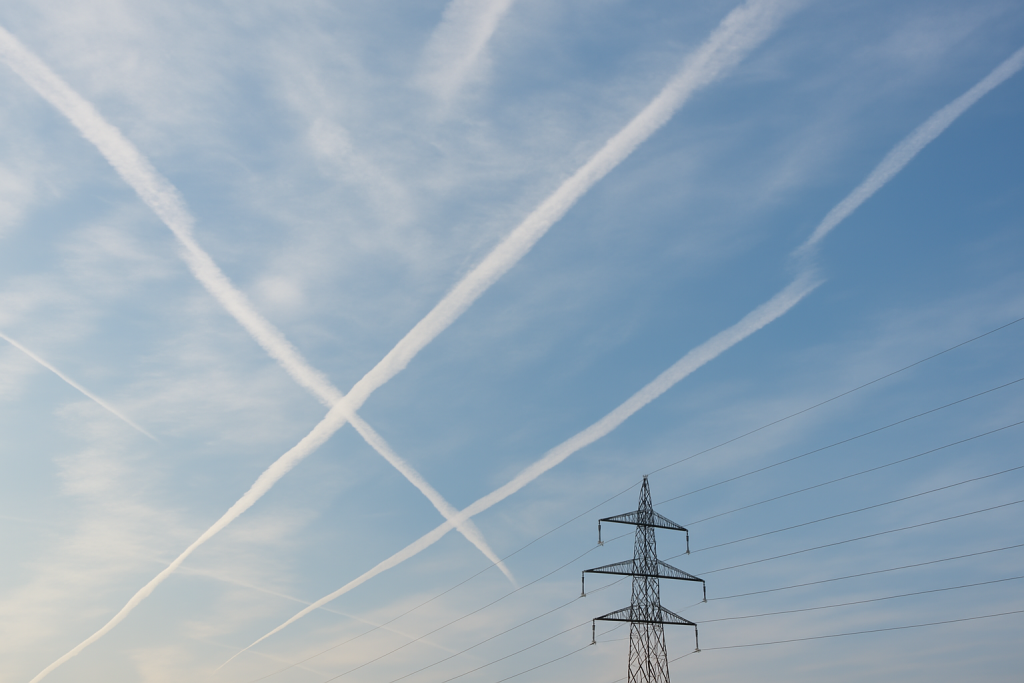By Dr. Merideth Quark, Atmospheric Dynamics Research Consortium (ADRC)
Published in The Baitman’s Journal of Atmospheric Studies, April 2025
Abstract
This exploratory review analyzes contemporary climate-altering phenomena through the lens of unintentional geoengineering. While the existence of large-scale covert weather control programs remains officially unsubstantiated, data collected from 2003–2024 indicates that human behavior may already be exerting measurable influence on atmospheric systems. Through the examination of persistent contrail density, urban heat island expansion, and hydrodynamic modulation via suburban lawn irrigation, we find statistically significant indicators that humanity is, in effect, conducting geoengineering—albeit clumsily, and without a central governing body.
Introduction
For decades, independent researchers have proposed that the weather is being manipulated by state actors via high-frequency devices, chemical dispersants, and ocean-based microwave pulse arrays. While such claims remain unconfirmed by peer-reviewed sources or anyone with a functioning printer, a growing body of data points to an inconvenient truth: human civilization, through its daily actions, has been geoengineering the planet by accident.
This study does not address claims regarding the HAARP array, 5G cloud penetration, or the 1997 “reverse rainbow” incident in Nevada. Instead, we focus on peer-reviewed climate data, commercial satellite imaging, and over 900 YouTube videos tagged “sky looks weird today.”
Methodology
The ADRC compiled atmospheric readings from 116 weather monitoring stations across North America, cross-referencing contrail persistence rates, urban temperature deviations, and particulate density ratios. Publicly available FAA flight tracking data was correlated with high-resolution images of “suspicious cloud formations” sourced from Instagram posts with fewer than 400 followers to avoid media bias.
Additionally, we analyzed:
Contrail Length-to-Visibility Ratios (CLVR): Measured in meters per second squared.
Ambient Urban Skew Thermality Index (AUSTI): A scale invented during this study.
Grass Moisture Reflectivity Effect (GMRE): The impact of lawn irrigation on local humidity, measured in “Evapo-units.”
Simultaneously, anecdotal reports were catalogued using a weighted believability matrix based on microphone quality, background flags, and whether or not the subject owned at least two reptiles.
Results
1. Persistent Contrails Mimic Intentional Cloud Seeding
Contrails formed by high-altitude aircraft were found to persist for up to 8.6x longer over commercial flight paths than in rural areas. While often dismissed as a natural result of atmospheric pressure and jet exhaust, these “accidental cloud bands” frequently resembled the intended outcome of formal cloud-seeding operations.
For example, the air corridor between Dallas and Atlanta showed a 32% increase in upper-atmospheric cirrus density, coinciding with days featuring heavy Chick-fil-A drive-thru activity.
2. Urban Heat Islands Have Replaced Traditional Weather Stations
Many urban centers show consistent anomalies in temperature due to concrete density, car exhaust, and what the study refers to as “dense mammalian clustering.” In Phoenix, Arizona, surface temperatures averaged 4.2°C higher than surrounding desert terrain, causing miniature pressure systems that alter wind currents regionally.
“It’s like building 900 microwaves next to each other and then pretending it’s not a weather device,” one researcher noted.
3. Suburban Lawns Disrupt Local Climate Through ‘Hydropathy’
Mass irrigation of ornamental lawns has created what scientists are calling “low-yield precipitation simulacra” or LYPS cells. These LYPS cells marginally raise local humidity, drawing in insects, fungal spores, and regret.
In a controlled neighborhood simulation in Bend, Oregon, one HOA with 78 homes increased ambient dew point by 0.3°F, solely through nightly sprinkler activity. No one noticed.
Discussion
While none of the above findings point to a deliberate, coordinated effort to engineer weather systems, the cumulative impact is undeniable. Much like a toddler with a chainsaw, the human race has stumbled into power it doesn’t fully understand, and instead of stopping, it’s building more parking lots.
If one were looking for evidence of geoengineering, one need only look around:
Your Amazon package flew over 4 states in a jet that made 12 miles of cloud.
Your driveway added 3 degrees to your block.
Your lawn just created a thunderfly outbreak.
These phenomena do not require global conspiracy. They require exactly what we already have: billions of people, all doing just enough damage to shift climate baselines without ever being organized enough to fix it.
Conclusion
Geoengineering is happening—not through secret labs, but through zoning permits, airplane routes, and suburban landscaping. The only real conspiracy may be the overwhelming desire to blame it on someone else.
As Dr. Quark concludes in her closing statement:
“We’re terraforming Earth. Badly. And no one is in charge.”
References
ADRC Atmospheric Contrail Report, 2019–2024
EPA Urban Heat Metrics Survey, 2022
Nextdoor.com Incident Log: “Weird fog on my patio again” (2023)
NOAA Thermal Skew Mapping via Google Earth (2021)
YouTube: “They Sprayed Again Today. Look Closely.” (19 views)

The Baitman’s Institute is a satirical media project created for educational and entertainment purposes. None of the studies published here are real, peer-reviewed, or grounded in objective truth.
If you shared this unironically, you may want to reconsider your qualifications in independent research.
